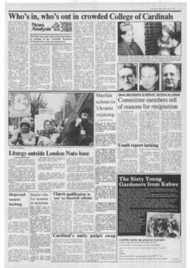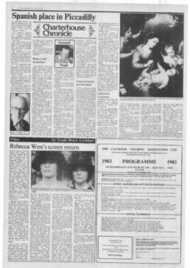Page 3, 14th January 1983
Page 3

Report an error
Noticed an error on this page?If you've noticed an error in this article please click here to report it.
Tags
Share
Related articles
Joy As Pope Awards Red Hats
Red Hats For 8
Pope John Springs Another Surprise At Consistory
History Made As Pope Creates 27 Cardinals
Day Of The Persecuted
Who's in, who's out in crowded College of Cardinals
The Pope has made some surprising choices in creating 18 new cardinals. Desmond O'Grady looks at the new men in red.
THE withholding of red hats in Pope John Paul's second consistory was as interesting as the granting of them. The American Archbishop Paul Marcinkus, who has been under attack for his running of the Vatican Bank (10R), missed out.
In his other role as governor of the Vatican City-state he was expected to be elevated to the cardinalate. But so were the Belgian Archbishop Jean Jadot and the French Archbishop Paul Poupard, heads, respectively of the SeCretariats for NonChristians and Non-Believers.
Their exclusion softened the blow for Marcinkus and may signify that the cardinalate is being reserved for those curial organs which govern the whole Church. The cardinalate was granted to two curialists, Giuseppe Casoria — the man who interrogated Ivan Illich head of the Congregation for Sacraments and Worship and Aurelio Sabattani, head of the Apostolic Signature tribunal.
No Vatican diplomat was made a cardinal as the culmination of what has been called "the apostolate of diplomatic receptions". Residential bishops had 15 of the 18 red hats but several sees usually considered "cardinalate" missed out: Washington, St Louis, Detroit, Munich, Lyons and Seville.
Admittedly some of these have a retired cardinal, but it means that if Pope John Paul holds another consistory in two years' time there will be far more "candidates" than red hats, for by then other cardinalate sees will have candidates. To give two examples: presumably a successor will be appointed to Cardinal James Freeman of Sydney who at 75 resigned, and an appointment will have been made to the Vacant see of Florence. • Pope John Paul seems to be edging the cardinalate towards a reward for merit rather than a right because of a function, such as occupancy of a particular see or completion of a career. This would be in line with giving greater responsibility to the College of Cardinals in the government of the Church rather than convoking it only for Papal elections.
Of course there are other factors involved than sheer personal merit: representativeness is one. In this consistory, the 18 cardinals are distributed in five continents, a symbol of the Church's catholicity.
In geographical terms, but not only for them, it is good to see that as well as a Cardinal in Beirut (Patriarch Antoine Pierre Khoraiche of Antioch for the Maronites) and Wellington, New Zealand (Thomas Stafford Williams), a cardinal has been nominated in Bangkok; Michael Michai Kitbunchu. Bangkok has suffered severely from the IndoChinese wars; suffered through the refugees flooding over the Thai frontiers, but even more from the inflow of money and drugs, because it is used as rest and recreation centre for American troops 4
No fewer than four new cardinals are from Eastern Europe. The cardinalate was expected for Joseph G,lemp of Warsaw but it is an endorsement for his policies when some Polish clergy are reportedly critical of his alleged compromises with Jaruzelski's regime. As leader of the large Croatian Catholic body, Archbishop Franjo Kuharic. Archbishop of Zagreb, was expected to become Yugoslavia's only cardinal.
The third Eastern European cardinal, Joachim Meisner, is described by the Vatican simply as Bishop of Berlin, for it does not recognise the division of the city. However he resides in East Berlin although responsible also for West Berlin.
The most intriguing of the Eastern European nominations, however, is that of 87 year old Julijans Vaivods, Apostolic Administrator of Riga, the first Cardinal ever in a Soviet republic. Vaivods, ordained priest in 1918, last October visited the Vatican and impressed with his piety. His appointment is a tribute to the hard-tested Catholic of the U.S.S.R.
The College of Cardinals' knowledge of Marxism is enriched through the appointment also of Alexandre do Nascimento who was kidnapped by guerrillas in Mozambique for a month last year. The other new African cardinal is Bernard Yago of Abidjan where Pope John Paul received a particularly warm welcome. The youngest of the cardinals is Alfonso Lopez Trujillo, 47, Archbishop of Medellin and President of the Latin American Episcopal Conferences. Trujillo, critical of liberation theology and with good links in the Roman Curia, is likely to be an influential cardinal for many years. The other new Latin American cardinal is the Archbishop of Caracas, Jose Ali Lubrun Moratinos.
A group of cardinals from 'first world' countries seem destined for a big role in Pope John Paul's church for the year 2000: the Archbishop of Paris, who is of Polish Jewish origin, Jean Marie Lustiger; Joseph L. Bernadin Archbishop of Chicago; Godfried Daneels, Archbishop of Brussels; and the Jesuit, Carlo Maria Martini, Archbishop of Milan described "papabitissimo".
Martini was the only Italian residential bishop nominated (both eurialista are Italian), bringing the number of Italians in the college to 35 out of 138. Not quite a quarter of the total, they are still the largest national group.
The batch of new cardinals is rounded off by the French Jesuit Henri de Lubac, 86, an endearing, white-haired theologian;
Eighteen of the 138 cardinals cannot participate in a conclave as they are over 80.
blog comments powered by Disqus











